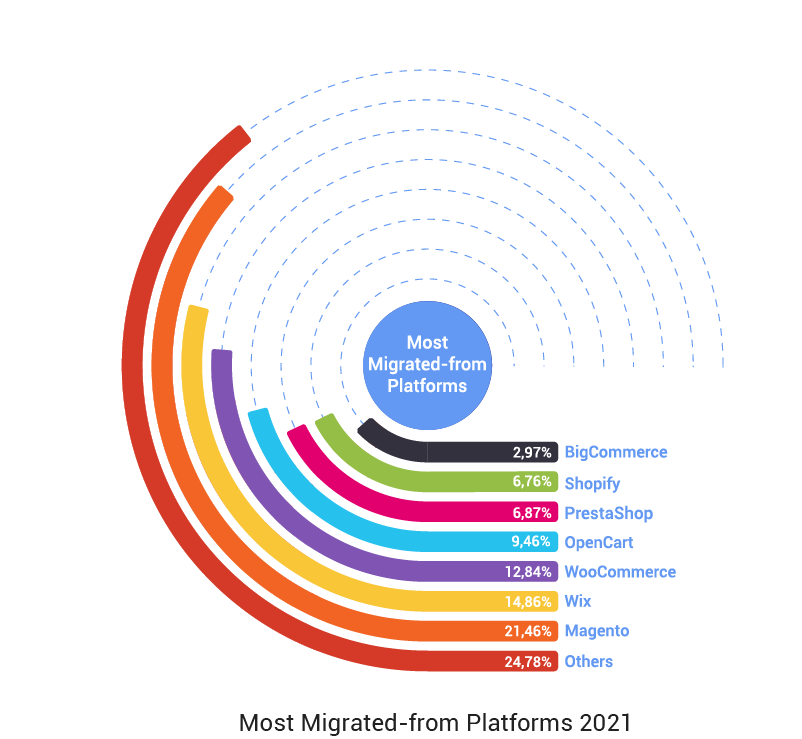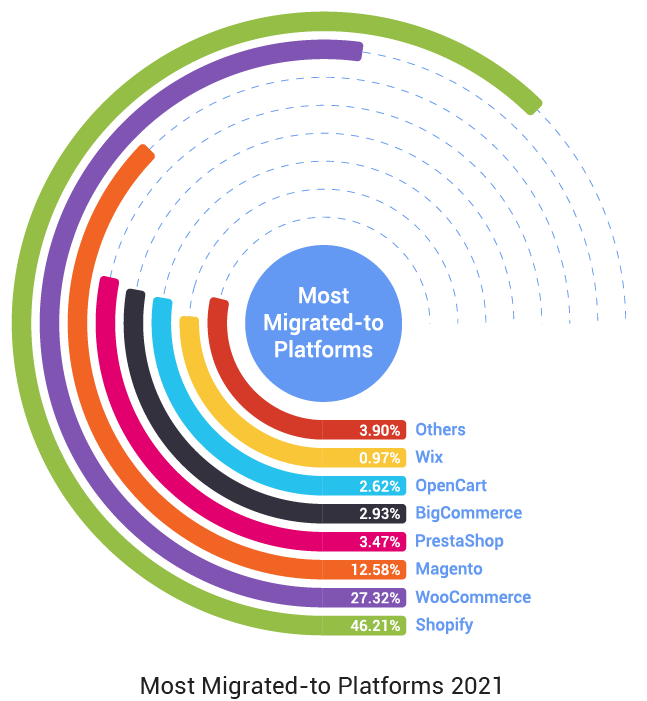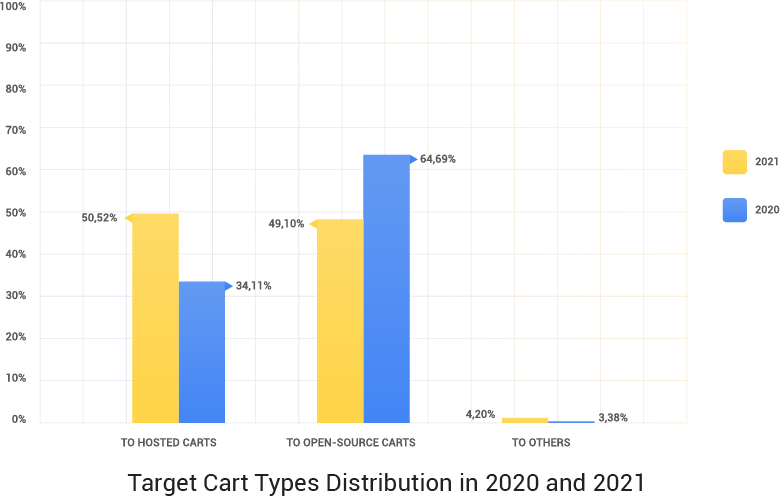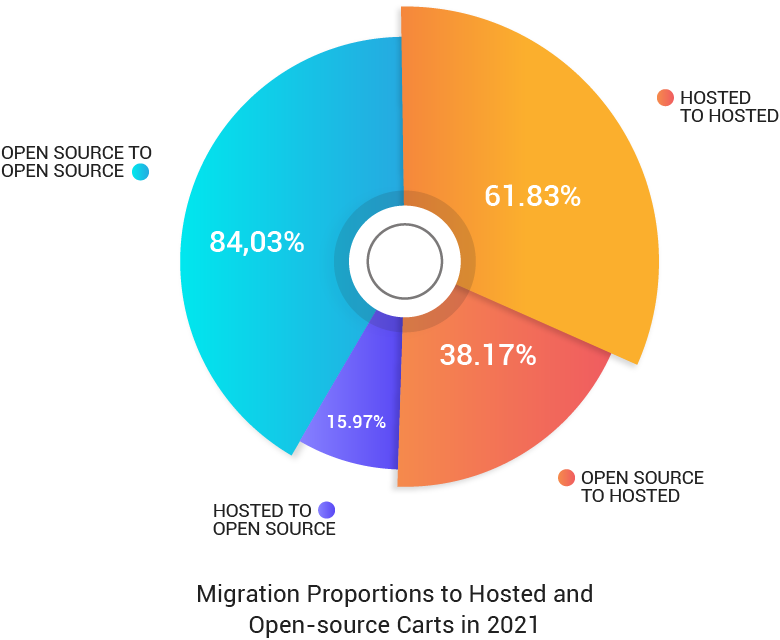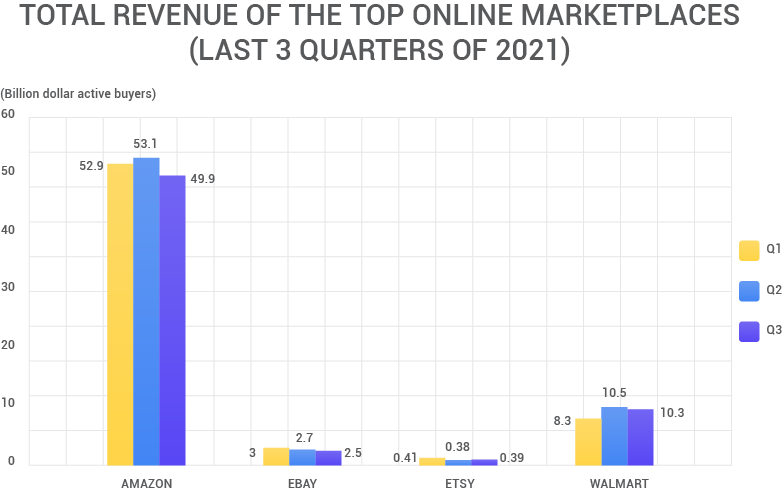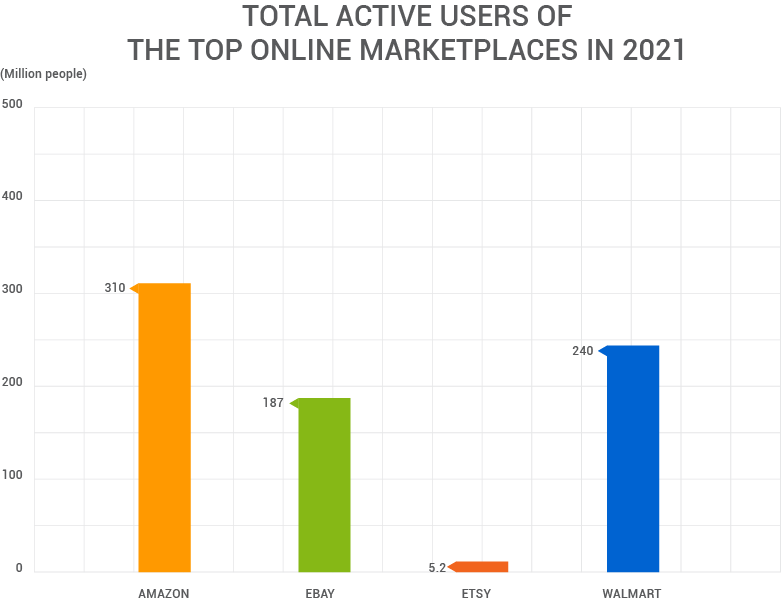ECOMMERCE REPORT
2021-2022
2021-2022
LATEST ECOMMERCE TRENDS & BEST ECOMMERCE PLATFORMS AND TOP MARKETPLACES 2022

OVERVIEW
For most brands, 2020 was all about survival and building out the basics of their eCommerce operations. Though 2021 was tough for many of them, eCommerce still opened new doors for brands that are here to stay. In 2021, they finally had a chance to come up for air and push the envelope into new areas – embracing newer types of commerce and investing in up-and-coming eCommerce platforms.
Digital transformation is helping retailers to stay ahead in the game, with new technologies being introduced and implemented. To ensure that businesses are well positioned for 2022, e-merchants must catch the latest trends in eCommerce, and really learn ways to adapt to these changes.
We believe our eCommerce report could be a trusting source that helps businesses strengthen their place in this competitive industry, and thus grow and flourish in 2022.
In this eCommerce report, we will be providing you with a research that:
- Recaps biggest eCommerce events in 2021 along with important statistics;
- Suggests latest eCommerce trends;
- Reveals shopping cart migration trends in 2021 (LitExtension’s in-house data);
- Reviews best eCommerce platforms in 2022 & top online marketplaces in 2022.
Fasten your seatbelts, we’re digging in!
I. ECOMMERCE REPORT 2021:
ECOMMERCE NEWS AND STATISTICS
eCommerce Events 2021 &
eCommerce Stats 2021
eCommerce Stats 2021
First, let’s take a look back at all the key eCommerce events and eCommerce statistics in 2021!
1.1. General eCommerce stats 2021
- In 2021, the number of digital buyers in Canada surpassed 25 million, making up for 68% of Canada’s population.
- Retail eCommerce sales worldwide in 2021 reached $4,891 billion.
- By January 2021 internet users in Indonesia purchase the most items online, with 87% of active internet users shopping online. This was the highest eCommerce penetration rate throughout the Asia Pacific region, followed by Thailand and Malaysia.
- At the beginning of the year, eCommerce in 2021 reached its highest peak in online shopping history. In February, 36.1% of the total retail sales was made online. Meanwhile, during the pre-pandemic season (February 2020), online retail only made up 20% of the total retail sales worldwide.
- Late 2021, eCommerce sales in all segments of all eCommerce markets decreased by an average of 20.73% in November 2021 compared to November 2020.
- With the consumer abandoning computer screens and moving back to street buying, direct-to-consumer (D2C) are on a meteoric rise. Online direct-to-consumer (D2C) sales by manufacturers rose by 20.5% and multichannel sales by 21.2% show the most significant increase compared to the third quarter of 2020.
- According to eMarketer’s forecast, US direct-to-consumer (D2C) eCommerce sales will reach $151.20 billion in 2022, an increase of 16.9% compared to 2021.
1.2. eCommerce platforms and marketplaces statistics
- Despite the shortage in the supply chain since the pandemic, Etsy has managed to produce positive results. Sales per consumer saw a significant increase, jumping nearly 25% compared to the same period last year. At the end of June 2021, Etsy’s sales per buyer reached $46.
- Walmart Inc. also witnessed an upward trend in the total eCommerce sales. It is reported to have grown from $15.9 billion to $17.3 billion in the same period the previous year.
- In the Southeast Asia market, Shopee generated massive sales after the November 11 Big Sale. Throughout this sale event, Shopee has successfully sold over 2 billion goods and items. Meanwhile, during the same period, Alibaba, another marketplace giant failed to achieve as impressive figures as expected.
- In 2021, the top 100 online marketplaces in the world generated an amount of $3.23 trillion by selling goods to consumers. Understanding the potential of these marketplaces, many retail giants have tapped into this fertile soil. Target introduced its marketplace version, Target+ in 2019; Walmart has been upscaling its platforms; and Google Shopping is coming after Amazon’s merchants.
1.3. eCommerce news and trends
- L’Oréal joined hands with TikTok to roll out eCommerce tools
- TikTok introduced TikTok Shopping
- According to Statista, the augmented reality market is valued at $30.7 billion, with around 810 million active mobile users.
- The coronavirus pandemic sped up consumers’ adoption of real-time payment options by 41%. Global mobile payments make up 46% of that figure, equalling a total of $102.7 billion last year
- The adoption of digital and omnichannel has increased to 62%
- Due to COVID-19, 40% of retailers adjusted return policies. Returns are also rising as more online shoppers “bracket” their purchases, buying multiple versions of a product with the intention of returning some items.
- Millennials and Gen Xers are the biggest online shoppers, with 67% of millennials and 56% of Gen Xers preferring to shop online versus in a brick-and-mortar store
eCommerce Platforms News & Updates
eCommerce platforms, or shopping carts, are still experiencing a surge in the number of new users in 2021. Specifically, there were 25,677,466 live websites using eCommerce platforms worldwide. Compared with 2020, the top 10 eCommerce platforms grew 52,16%.
The race between eCommerce platforms has never stopped, and 2021 was definitely a year of big changes. Let’s journey back to list the biggest news and updates of current top eCommerce platforms!
Events | |
| |
| |
| |
| |
| |
| |
| |
| |
| |
| |
| |
|
II. LATEST ECOMMERCE TRENDS IN 2022
ECOMMERCE REPORT AND EXPECTATIONS

1. Mobile Commerce
The COVID-19 pandemic has accelerated many eCommerce trends that were already in motion, including the proliferation of eCommerce experiences with mobile devices, often known as mobile commerce.
What is Mobile Commerce?
Mobile commerce or m-commerce, simply put, is an eCommerce subset that involves the purchase and sale of goods through a mobile device such as a smartphone or tablet.
While the word “trend” seems to be short-term, mobile commerce is not just a flash-in-the-pan trend, but it’s here to stay. According to eMarketer, mobile sales generated from smartphones are forecast to reach $432.24 billion in 2022.
Why should e-merchants catch trend of Mobile Commerce?
With the ability to shop with a smartphone on-hand, customers can access a wider range of products, do product research before purchase and shop from the comfort of their own homes.
The rapid growth of mobile shopping has benefited store owners in many ways. Now, merchants can send customers SMS push notifications whenever they’re on the go. Besides, the advance of Wi-Fi and GPS technology has paved the way for store owners to reach their customers with more personalized and location-specific content.
Mobile Commerce for eCommerce merchants
Given the potential of mobile commerce for businesses, it’s no wonder that more and more brands are looking into methods to adapt to this mobile-driven economy.
The most crucial yet overlooked way that brands can do is to create a mobile-friendly eCommerce store by choosing a responsive design, optimizing product presentation and simplifying the checkout process.
Best eCommerce platforms like Shopify or BigCommerce offer a variety of mobile integrations and features such as mobile-responsive themes, one-click checkout and a mobile app – to support the best shopping experience for clients.
Another factor that can make a good contribution to the overall 5-star shopping experience is the 24/7 customer service. However, if your human resources are limited, mobile chatbots and virtual assistance can step in as ideal customer supporters. The installation of a chatbot plugin is simple and works for any site, no matter where you build your eCommerce store – on open-source software or a hosted platform. In 2019, global consumer retail spend via chatbots was valued at $2.8 billion, but the number is expected to multiple 50 times – about $142 billion by 2024.
2. Social Commerce
The exponential growth of mobile commerce has triggered an increase in the use of social media for commercial purposes.
What is Social Commerce?
The process of selling items directly on social platforms is often known as social commerce. With Instagram social commerce, Facebook social commerce, TikTok social commerce or any other social commerce platforms, the entire shopping experience — from product discovery and research to the check out process — takes place right on a social media platform.
According to eMarketer, the number of US social commerce buyers grew to over 80 million in 2020 and is anticipated to increase to 96.1 million in 2022. On the global scale, Accenture forecast social commerce statistics will reach $1.2 trillion by 2025, accounting for 16.7% of total eCommerce spend.
Why should e-merchants catch Social Commerce trends?
Social commerce cuts out all the obstacles to bring a seamless and friction-free shopping experience for customers. The purchase journey, for instance, is now being shortened as buyers are already logged in the app with their payment details ready to go.
The statistics from Statista reveal that by 2023, 71% of small businesses plan to sell on social media platforms. With more and more vendors embracing social commerce in innovative ways, it’s likely that its benefits are not limited to shoppers.
Social media platforms, without a doubt, are fertile land for brand equity to grow. As buyers share and repost products, brands stand a higher chance of expanding customer base. That’s the power of positive word-of-mouth!
Besides, social commerce also helps to improve customer interaction. Social commerce offers both parties a humane connection in a way that traditional eCommerce cannot. Through social networks, brands can instantly communicate with customers, address their issues and enhance customer service based on their feedback.
Social Commerce for eCommerce merchants
Understanding the potential and the benefits of social commerce, most brands, if not all, are racing to get as big a piece of this pie as possible.
If brands haven’t integrated the eCommerce store with social platforms, it’s time to rethink that stance! In fact, eCommerce giants like Shopify, WooCommerce and BigCommerce all support social integration with Facebook Shop, Instagram Shopping and Pinterest Business.
In August 2021, Shopify introduced a new-in app shopping experience on TikTok. Shopify merchants with a TikTok For Business account could add a shopping tab to TikTok profiles and sync product catalogs to create a mini-storefront that links directly to the online store for checkout.
And for brands pivoting to social media marketing, it would be a huge mistake to dismiss live streaming commerce. Indeed, live streaming as a method for product discovery is strongest in the Chinese eCommerce market. Whilst, in the West, live commerce is mostly in the testing phase and forecast to be more widespread in the next year. Therefore, merchants will need to be prepared to be creative to stay ahead of the curve. And to maximize the power of live commerce, brands can consider inviting niche experts to join the live streamed videos and share their reviews.
3. Digital Payments
What is Digital Payment?
Digital Payment is the process of transferring money between sellers and buyers via online payment methods or digital devices (mobile phone, Point-of-Sale system,…)
To put it differently, with digital payments, customers can purchase their product using digital wallets, credit/debit cards, crypto payment or other forms of eCommerce payments, instead of having cash or check involved.
In the scope of this report, LitExtension will closely observe the surge of two eCommerce checkout innovations: e-wallet and Buy Now Pay Later – the payment option that allows customers to pay for their purchase on a future date.
Digital Payments Statistics in 2021
Amidst the pandemic, consumers’ demand for contactless and frictionless digital payments is increasing. According to Statista, the total transaction value of digital payments is predicted to double in the next 4 years, from 5,425,300 in 2020 to 10,715,390 in 2025. According to Statista’s latest update, 2.14 billion – nearly 30% of the world’s population are digital buyers.
eCommerce checkout innovations like e-wallet and Buy Now Pay Later continue to grow rapidly. As projected by FIS Global, the use of e-Wallet will account for 51.7% of the total eCommerce payment volumes by 2024. Currently, digital wallets are the leading online payment methods in several regions, including North America, Europe, and the Asia Pacific.
Meanwhile, Buy Now Pay Later is poised to double its market share in 2024, FIS Global reported.
On another note, the rise of crypto payments in 2021 is unignorable. According to McKinsey, although the penetration of crypto-currencies has reached a plateau, there is a noticeable number of customers who have been using crypto as payment.
What Are the Benefits of Digital Payments?
The growth of digital payments clearly indicates that e-merchants should embrace new technologies in eCommerce checkout. With a great variety of payment options, e-merchants will stand a higher chance of boosting their revenue.
By providing e-wallet and Buy Now Pay Later as payment options, giving the right marketing, e-merchants can attract a large volume of visitors coming to their online stores. Business operators can cash in on this traffic and convert these visitors to their customers.
On another note, accelerated and convenient digital payments also increase customers’ experience when shopping online. As a result, it can reduce cart abandonment and increase sales volume.
Besides, with the Buy Now Pay Later function enabled, customers can now shop without worrying about their current financial situation. This feature will prompt customers to purchase more and thus increase average order value.
Digital Payments and eCommerce Platforms
Understanding the importance of digital payments, several eCommerce platforms allow store owners to accept digital payments like e-wallet, Buy Now Pay Later and cryptocurrency as one of their eCommerce checkout options.
Many hosted solutions have rolled out their own version of eCommerce payment gateway, namely Wix Payments and BigCommerce Payments. These integrated payment platforms are now in partnership with financial behemoths like Klarna, Affirm, or Afterpay to provide Buy Now Pay Later as an installment solution.
Outstandingly, Canadian eCommerce giant Shopify even teamed up with Affirm in July 2020 to roll out the Buy Now Pay Later on Shop Pay, an exclusive installment function for Shopify users.
On another note, following this eCommerce trend, Wix has joined hands with BitPay to offer crypto payment. As a result of this integration, Wix merchants can now accept crypto payments in 12 different digital coins.
Also, open-source solutions are packed with powerful plugins to provide eCommerce checkout functions to store owners. With the partnership of WooCommerce – VivaWallet, OpenCart – Stripe, and PrestaShop – Braintree, online shoppers can use digital wallets for fast checkout.
4. eCommerce Sustainability
What Is eCommerce Sustainability?
eCommerce sustainability is the attempt of online store owners to turn their businesses into eco commerce. Sustainable eCommerce enables shopping green online by adopting green technology, selling sustainable products, or using eco friendly packaging.
eCommerce sustainability is not among the new eCommerce trends, yet its effect still echoes down the ages. Besides the impact it has on the environment, achieving eCommerce sustainability also contributes to the success of online stores, in many different ways.
Several pieces of research have dedicated that more and more consumers are taking heed of the environment. According to Retail Dive, nearly 60% of customers are willing to purchase from sustainable eCommerce brands in the next two years. A considerable number of them agree with the idea of shopping green online to reduce the negative impact on the environment.
What Are the Benefits of eCommerce Sustainability?
With the steady increase in the number of environmentally-conscious consumers, eCommerce sustainability companies can avail this golden opportunity to attract more visitors. By adopting suitable tactics to boost conversions, these visitors might turn into loyal customers and significantly increase sales.
Furthermore, e-merchants can use eCommerce sustainability as a bellwether to enhance their brand image. Being a sustainable eCommerce company will make your store’s presence felt, thus store owners stand a higher chance of differentiating themselves from other competitors in the market.
Sustainability in eCommerce
When it comes to eCommerce sustainability, Shopify is renowned as a leading platform in protecting the environment. This hosted solution has rolled out Shopify’s Sustainability Fund along with several commitments to fight against climate change.
In 2018, Shopify has successfully and entirely shifted their data servers to Google Cloud whose energy comes from 100% renewable resources. As a result, when operating a Shopify store, e-merchant is transforming their online business into a sustainable eCommerce.
On the same wavelength with Shopify, Amazon introduced The Climate Pledge program in 2019. This is a determined attempt of this eCommerce behemoth to play its part in protecting the environment by deploying green technology.
Amazon commits to diminish carbon emission on its delivery system. Therefore, when merchants sell on Amazon, they can take advantage of this decreased-carbon shipment.
Meanwhile, Etsy tackles environmental issues in a different approach. This marketplace provides its sellers with eco-friendly packaging made from 100% recycled materials or certified responsibly sourced paper. Besides, Etsy is making an effort to offset 100% carbon emissions from shipping and packaging on every delivery.
5. Omnichannel eCommerce
Omnichannel Definition
Omnichannel eCommerce is a multichannel approach that focuses on providing shoppers with a seamless experience on every channel or touch point.
To put simply, with omnichannel eCommerce, customers can simultaneously use multiple channels in their shopping journey, starting their product search at one channel and making the purchase in another one.
More importantly, omnichannel retailing implies the integration of inventory, customer service, and sales to offer a seamless transition and management between channels for store owners.
Omnichannel Statistics in 2021
Let’s look at some interesting figures to see why omnichannel eCommerce is becoming the new normal.
In 2021, people tend to buy online and pick up in-store (BOPIS). In a global survey, 74% of in-store shoppers who searched online before going to the store to shop. Also, buying online and returning in-store is another new normal in shopping behaviors. Shopify surveyed that 51% of consumers said the ability to check out online and return items to a brick-and-mortar store had a significant influence on their buying decision. Accordingly, 44% of brands said they planned on prioritizing this in 2022.
With the surge of multi-channel shopping from consumers, retailers are embracing the trend by expanding their online presence to multiple channels to catch up with the demand. In the first quarter of 2021, U.S. retail eCommerce sales totaled more than $215 billion, up from $154 billion in the first quarter of 2020. Omnichannel retail is expected to exceed $491 billion in 2022 — a 15% increase from 2021, but omnichannel retail will feature personalization in 2022.
Omnichannel Retailing’s Benefits
An omnichannel strategy helps you expand brand’s reach to new customer segments. Each sales channel has a certain customer base, you can exploit its benefits to market products to target audiences.
Omnichannel marketing can boost conversion rate if segmentation and personalization are done correctly. With dynamic content based on customer-behavior, clickstream data, context, product recommendations, and exclusive personalized offers, digital retail brands can significantly increase their customer engagement.
Businesses can take advantage of omnichannel to increase brand awareness by presenting their products on various selling channels from online to physical store. With an omnichannel strategy, you can make a shopping journey as comfy as possible for customers. They don’t have to waste time looking for you. Your team or products are simply a click, an email, a direct message, or a phone call away, no matter where customers are.
Omnichannel Strategy for eCommerce Sellers
Here are some of the best practices that you can adopt to create an effective omnichannel strategy:
- Segment target audience wisely across sales channels: Well-defined consumer segmentation is necessary for an efficient omnichannel marketing approach. The more segmented the plan is, the more effective it will be.
- Create different content for each sales channel: You’ll be able to target consumers in a variety of ways, including sending SMSs, emails, and push notifications. It is preferable to generate a personalized message for all channels.
- Retarget audiences: You shouldn’t remove a customer from your targeted customers’ list if they did not make a purchase in the first attempt. You can increase the chances of conversion by showing them relevant banner ads on different platforms, including social media marketing platforms.
- Make use of automation tools: Marketing automation tools are always a good choice to segment your audience properly. You can also integrate web stores with marketplaces to automate your workflow. Shopify, WooCommerce, and Magento offer plugins with multichannel selling features, while BigCommerce allows selling on marketplaces with its native features.
6. Artificial Intelligence (AI) &
Augmented Reality (AR)
Augmented Reality (AR)
What is Artificial Intelligence (AI)?
Artificial intelligence (AI) refers to a smart system that mimics human intelligence to perform complicated tasks with a high degree of accuracy. AI can improve itself based on the mistakes it made, and the information the system collects.
What is Augmented Reality (AR)?
Augmented reality (AR) is the combination of digital visual elements, sound, or other sensory stimuli delivered via technology to create a version of the real physical world. With the AR applications, eCommerce stores let customers experience the product or service in their own environment and on their own time. For example, when buying a watch online, AR can show shoppers how it will look in your hand so they can be more confident to purchase.
AI and AR Statistics in 2021
AI has been around for a long time, yet the booming of AI applications in eCommerce is just getting started. There’s no doubt that AI is the technology of the future, especially for eCommerce.
In the next 3 years, the adoption of AI technology for eCommerce retail and consumer product industries is expected to increase from 40% – 80%. That’s why the industry is seeing a rapid expansion with over $7.3 billion projected to be spent on AI by retailers in 2022.
In parallel with AI, augmented reality (AR) is also a big trend in eCommerce. Google found that 66% of people are interested in using augmented reality technology for help when shopping. Overall, more than 83 million people in the U.S. will use AR on some kind of device at least once per month, and it is expected to rise to 95.1 million by 2022.
What Are the Benefits of AI and AR?
- Enhance customer experience
One of the biggest applications of AI in eCommerce is to personalize the customer journey to deliver a better shopping experience. AI pricing recommendations and AI product recommendations are the two amazing features for e-merchants to level up their stores.
How about AR? The best application of this technology in eCommerce is the “try before buying” function. It allows shoppers to try the product online and see how it works for them. This way, the shopping experience can be much more exciting. Hence, more converting potentials!!!
- Improve merchant’s store’s functionality
Having an AI-powered visual search engine toolbox can really boost the store’s functionality. Instead of using simple texts, shoppers can input real-world images such as snaps, screenshots, internet images, etc and the system will find the suitable results. This will be extremely useful for the clothing or home decor industry.
With the “Marker-based AR” feature, merchants can create a whole virtual space of an environment such as a customer’s living room, kitchen… so customers can preview how the item will fit in that particular scene. Marker-based AR will be incredibly helpful when selling household items, furniture, design materials…
- Better customer support service
Customer service is always the heart of an online business. If customers are mostly reaching store owners with the live-chat box, using an AI chatbot can bring a big benefit. It is the live-chat assistance (text- or voice-based interfaces). Chatbot can learn to adapt to the customer conversation and gets smarter day by day. Even though an AI chatbot can not replace the entire live-chat functionality, it can still be a big helper.
AI and AR in eCommerce
Knowing the powerful functions of AI and AR, store owners can create a strong impression to capture a shopper’s attention at first sight.
Fortunately, it’s quite simple to apply AI and AR for an eCommerce store if aiming for the right direction. Let’s go through some scenarios where merchants can easily apply AI and AR using the available technology on their eCommerce platform or marketplace.
- For Magento’s store, merchants can go ahead and install the Live Search and Product Recommendations powered by Adobe Sensei for the Magento store. The process is quite simple yet the store’s performance can be much better with these amazing functions.
- For Amazon sellers, the retailer giant brings many AI applications for merchants including AI-powered search engines. AWS offers Amazon Kendra, an intelligent search service powered by machine learning helping customers quickly return accurate answers from unstructured content.
- Shopify is surely the leading eCommerce solution that provides AR technology as built-in features. Shopify’s merchants can use the Shopify product media to make 3D models to level up the appearance of the product in just some simple steps.
Following are the best eCommerce platforms suggested based on LitExtension’s in-house re-platforming data throughout 2021, along with in-depth analysis of each shopping cart’s best features. Be wise to choose the up-and-coming platform for your business!
III. SHOPPING CART MIGRATION TRENDS

In this part, we will be looking into LitExtension’s in-house data. Proud to be the #1 Shopping Cart Migration Expert, LitExtension’s annual report could be a reliable source for online merchants to have a crystal-clear view of shopping cart migration trends in 2021.
To be specific, the below discoveries are analyzed based on our shopping cart migration data from 01/01/2021 to 12/31/2021. Our migration data include Source Carts and Target Carts, time, date and region of specific migration projects.
As the field “Region” is not a required field when filling in information with LitExtension, some of the regional data is missing from our database. For those cases, we instead used the location collected from the country code top-level domain (ccTLD) or the default language or currency of the sites. Doing this does not ensure maximum accuracy regarding the location of the merchants as they may be overseas sellers, but on the other hand, it reflects the choices for particular markets. Additionally, the number of missing data is not large enough to lead to a huge different or imprecise eCommerce industry trends prediction, hence the unbiased results.
Since the migration trends are influenced by multiple factors, our findings may also differ from global huge brands’ reports as our in-house data does not represent the whole eCommerce industry. However, our target market is not limited to particular areas and our customers come from a variety of regions, so the results can be applied worldwide.
In this part, let’s discover:
- Most migrated-from eCommerce platforms
- Most migrated-to eCommerce platforms
- Global shopping carts migration trends
- Most favorite platform type: Open source vs Hosted
1. Most Migrated-from eCommerce Platforms
The bar chart below depicts the top 7 most migrated-from platforms in 2021, which tend to be similar to the top migrated-from platforms in 2020.
These 7 aforementioned carts comprised 75,22% of the total number of Source Carts. Especially, Magento, Wix, and WooCommerce accounted for 49,16%.
In 2021, Magento was top 1 migrated-from cart, accounting for 21,46%. In particular:
- 37,85% of online sellers transferring their stores from Magento continued toupgrade from Magento 1.0 to Magento 2.0.
- 16,78% of people who decided to leave Magento migrated from Magento to WooCommerce.
Wix ranked in top 2 Source Cart with 14,86%. Despite the fact that Wix has a large proportion of market share as well as live websites, this website builder has slow performance, limited scalability with a poor marketplace and optimization-less. As said, with 87,10% of migrations moving from Wix to Shopify, this hosted platform was the most popular destination for Wix users.
WooCommerce topped 3, constituting 12,84%. People tend to leave WooCommerce due to the fact that this platform is quite expensive, requires a steep learning curve, lacks direct support, and has a slow loading time. Apparently, 55,05% moved from WooCommerce to Shopify and 12,08% switched to Magento in 2021.
OpenCart topped 4th migrated-from platforms, consisting of 9,46%. 48,97% of users left OpenCart for WooCommerce. It seems that OpenCart has been left out of the eCommerce run in 2021 since the platform didn’t have many big updates and improvements for its users.
Standing in the 5th of this list, PrestaShop made up 6,87%. Particularly, 12,54% of migrations from PrestaShop upgraded from PrestaShop 1.7.7 to 1.7.8 version, and 52% of migrations from PrestaShop headed to WooCommerce.
2. Most Migrated-to Platforms
The given bar chart demonstrates the top 7 most migrated-to platforms in 2021. Top 3 migrated-to platforms in 2021 remained Shopify (46,21%), WooCommerce (27,32%), and Magento (12,58%), with a total of more than 85% Target Carts.
Shopify reaffirmed itself as the most popular destination for merchants with 46,21% migrations to Shopify, increasing 10,75% compared to our statistics in 2020. Particularly, Shopify was most favoured by users moving from Wix (28,01%), WooCommerce (15,29%), and Magento (14,82%)…
WooCommerce was the runner-up after Shopify, occupying 27,32%. We have looked closely at the data, and what we found was rather surprising. In 2021, Shopify obviously outperformed WooCommerce since the number of users moving to Shopify in 2021 was 18,89% higher than that to WooCommerce. In 2020, this number was only 4,32%.
Magento ranked 3rd, accounting for 12,58%. Compared to 2020, the number of migrations to Magento dropped 7,82%.
Last but not least, it is worth mentioning PrestaShop and BigCommerce. These 2 platforms were top 4 and top 5 favorite Target Carts, taking up 3,47% and 2,93% migrations respectively.
Notably, in 2021, PrestaShop climbed to the 4th position whereas OpenCart fell from top 4 to top 6 with only 2,62%.
With BigCommerce, a great number of migrations from Shopify (25%) and Magento (21,32%) contributed to its 5th position.
3. Global Shopping Carts Migration Trends
The world map above illustrates the global shopping carts migration trend based on LitExtension’s in-house data.
At first glance, we can see that Shopify and WooCommerce were the two most popular eCommerce platforms worldwide.
In America, online merchants preferred to build their stores on Shopify.
European online merchants seem to choose Shopify and WooCommerce to kick off their online businesses.
In Asia, while Shopify, WooCommerce and Magento gained great popularity in 2020, Shopify was the outstanding name reported to be predominant in 2021.
4. Most Favorite Target Cart Type: Open Source vs Hosted
When looking at the Target Cart types distribution in 2021, the proportion of migrations to hosted carts took up 50,52% which was higher than that to open-source platforms with 49,1%.
In 2020, 64,69% of online merchants decided to move to open-source platforms and 34,11% of them moved to hosted alternatives.
This trend was in parallel with the trend of live websites where hosted platforms were preferred over open-source ones.
Looking a little closer, the proportion of hosted to hosted migration was higher than open-source to hosted, adding up to 61,58%. In the meantime, open-source to open-source migration constituted 84,03%, which was higher than open-source to hosted amount. This tendency is congruent with the 2020 trends.
5. Conclusion – Best Online eCommerce Platforms in 2021
At the end of the day, we came up with the top 6 best eCommerce platforms in 2021, namely Shopify, WooCommerce, Magento, PrestaShop, BigCommerce and Wix. In 2020, these platforms also made their way to being top eCommerce solutions.
Here comes some notable conclusions:
- Top migrated-to platforms: Shopify, WooCommerce, Magento, PrestaShop, BigCommerce.
- Wix is growing in popularity.
- Preferred cart type: Hosted platform.
IV. BEST ECOMMERCE PLATFORMS IN 2022

It can be stated that eCommerce platforms and technologies usage has been booming. In 2021, there were 25,677,466 live websites using eCommerce technologies worldwide. Compared with 2020, the top 10 eCommerce platforms grew 52,16%. Some notable names experienced a steep rise in their live websites, including Shopify (175%) and WooCommerce (25,87%).
Finding the best eCommerce platforms in 2022 is the pinnacle of your selling strategy. A multi-functional platform can facilitate every stage of your online business in the path ahead. However, it’s surely not an easy-making decision since there’re lots of factors that need to be taken into consideration.
In this part, we will be providing you with the top 6 best online eCommerce platforms in 2022 and who they are well-suited for. These are factors we had thoroughly analyzed, and thus, came to the conclusion:
- eCommerce platforms’ popularity in 2021
- Platform’s best features and key updates in 2021
- LitExtension’s shopping cart migration trends
Besides, we also have regard to customer reviews because they are presumably one of the best ways to give you the most accurate insights about a platform.
Please note: There are two versions of Magento: Magento Open Source and the cloud-based solution Adobe Commerce. In this report, we’ll be solely looking at its open-source version, which is what most people are referring to when mentioning “Magento”.
Let’s dive in!
Best Hosted eCommerce Platforms:
#1 Shopify
What is Shopify?
In Hawaiian, Kahuna means “a wise man” or “shaman”. In the arena of eCommerce solutions, the all-in-one hosted Shopify has always been praised as the biggest Kahuna, in large part because it’s uber-easy to use yet highly scalable with a plethora of apps and a great degree of customizability. That said, Shopify is undoubtedly the go-to platform for all-size businesses.
Why Shopify is one of the best eCommerce platforms
Notably, in terms of live websites available in 2021, Shopify has risen to the top spot with 3,882,345 live websites, replacing WooCommerce’s 2020 top position.
According to a financial announcement of Shopify, the gross profit of this platform grew 50% to $608.9 million in the third quarter of 2021, compared with $405.1 million for the third quarter of 2020.
Clearly, having the most migration projects to Shopify, Shopify secured its position as the best hosted eCommerce platform in 2021.
Let’s have a look at the best Shopify’s features and updates that build up this popularity
Dipping toes in online selling, Shopify definitely makes things easier for e-merchants with a chock-full of attributes packed into a user-friendly environment. Shopify has it all: easy setup with an intuitive dashboard area for quickly adding products, tweaking site appearance and much more. The same simplicity applies when managing customers, orders and inventory.
Also, Shopify strives to support customers in so many ways to ensure the best customer experience for its users. There are three main ways to get instant support from Shopify, namely 24/7 live chat, phone and email support. More than that, the Shopify knowledge base and community forum are the two places where merchants could find insightful responses to almost every common question.
Being a solid option for enterprise businesses, Shopify efficiently supports business growth. First off, Shopify offers its users a humongous library of over 6000 Shopify apps (BigCommere apps and Wix apps number in the hundreds). Furthermore, Shopify users are able to access its HTML, CSS and Liquid code to make some adjustments to the presence and functions of the store. Should these advanced features be insufficient for stores’ development, Shopify also offers a tailor-made enterprise eCommerce platform for large-scale businesses – Shopify Plus.
2021 was the year of exponential growth and continual improvement of Shopify. With the aim to ensure the best experience for both merchants and shoppers, this eCommerce giant has made lots of innovative updates.
- Among those, the most important update is Shopify users can now directly report partner violations and critical issues to Shopify.
- Also, in Q1 2022, Shopify will be migrating the merchant store admin from the myshopify storefront domain to admin.shopify.com. This upcoming update will improve the experience of working across multiple stores.
All things considered, there’re just no reasons for the slowing down of Shopify in the year 2022 and Shopify is forecast to remain its crown jewel in the world of eCommerce platforms.
“Shopify is amazing for multiple reasons, but the App Store, it’s incredible”
“When you get to the point where you have a great volume of orders, and you’re really looking for that next level of support, Shopify Plus is something that we moved on to once we felt we were ready for that next stage of development. Having that flexibility with Shopify Plus has been so excellent for giving us the tools to build out some customizations.”
Jeanne Foley, Co-founder of The Groomsman Suit.
Best Hosted eCommerce Platforms:
#2 Wix
#2 Wix
What is Wix?
Wix is an all-in-one website builder tool that allows users to quickly set up their website for multiple purposes. It is packed with a great wealth of features to support e-merchants, including an easy-to-use design tool and hundreds of ways to get paid.
Notably, everything Wix offers comes with an affordable price and no technical skill required. Therefore, it would be an easy approach for new eCommerce users who have few products and are not well versed in technology.
With these outstanding functions, it is no doubt that Wix website builder is one of the most popular eCommerce platforms in 2022.
Why Wix is one of the best eCommerce platforms
Currently powering over 1 million live Wix websites and accounting for ⅕ of the total eCommerce market share.
One of the main reasons that make Wix eCommerce a top platform is that it requires a smaller amount of money to begin selling. The Wix pricing plan starts at $23 per month, while BigCommerce and Shopify asks for at least $29 per month. Small businesses that are running on a tight budget can make full use of Wix’s free pricing plan to start selling online.
Besides, Wix distinguishes itself from other competitors in the market by offering three top-of-the-class website builder tools. Depending on users’ purposes, they can choose among Wix ADI, Wix Editor, and Wix Editor X to design their website. Whether they want to build a personal blog or make a Wix eCommerce online store, this platform can easily meet the demand of users.
What’s more?
- Wix payments constantly follows industry trends to update its systems. From installment options Buy Now Pay Later to fast checkout with digital wallet, Wix can offer users the latest eCommerce payment trends. In October 2021, Wix joined hands with BitPay and became one of the earliest eCommerce platforms that accept crypto payment in their online store.
- Wix dashboard grants users access to a plethora of website themes. Notably, all 831 Wix templates are free to use and customize. It would be highly beneficial for eCommerce users who do not have a strong financial background.
- Wix allows store owners to freely edit every element in their sites without having to access coding.
Wix makes sure it’s users can catch the latest eCommerce trends with timely updates:
- In January, Wix announced new ad format for Facebook & Instagram Ads
- Wix added Amazon as a sales channel on Wix Stores in March
- Two months later, Wix acquired Rise.ai to add gift cards and loyalty to eCommerce platform
- In August, Wix presented Branded App to create mobile app without coding
- In the last quarter of 2021, Wix joined hands with Apple Pay to offer fast checkout, and with PayPal to roll out Pay Later for Wix merchants.
Now, let’s take a look at this Wix review to see what Wix user think about this platform.
“As to be expected there was a slight learning curve, but overall it was user-friendly. Once I started to design, I was up and running within a day. From there, I continued to tweak and add stuff. Every now and then I receive an email from Wix with new tips and those are really helpful.”
Mitchel Wu – Owner of Mitchel Wu Toy Photography
Best Hosted eCommerce Platforms:
#3 BigCommerce
#3 BigCommerce
What is BigCommerce?
Beforehand, BigCommerce is a leading hosted solution with an easy-to-use interface and advanced built-in features. This platform has claimed that more than 50,000 online stores in 150+ countries use their eCommerce software.
BigCommerce is highly optimized to host big eStores. Thus, it can be considered to be the best suited for someone who’s growing fast and wants to operate at scale.
Why BigCommerce is one of the best eCommerce platforms
Before all else, BigCommerce is a full-fledged platform that listed itself among the top migrated-to platforms in 2021. BigCommerce definitely can help your business scale better and easier.
Besides, BigCommerce deserves a big round of applause for its strong built-in features, including abandoned cart recovery, single-page checkout, bulk pricing…, which clearly reduces your reliance on third-party programs. You have all you need right at your fingertips, at no additional expense.
What’s more? BigCommerce offers more than you expect:
- Before making a payment, BigCommerce offers a 15-day free trial for a number of apps, which can save its users a pretty penny.
- This platform has more POS integrations than any other eCommerce platform with Connect POS.
- BigCommerce also has its own all-in-one solution for next-generation shipping solutions – BigCommerce Shipping App and ShipStation integration.
- Automatically upgrading pricing plans, BigCommerce handles everything for you so you can focus on growing your business!
Being in a constantly changing eCommerce world, BigCommerce timely updates to trends in order not to lag behind its competitors. With Social Commerce, BigCommerce enables users to capture more customers on social channels with Facebook, Pinterest, and Instagram integrations. The Digital Wallets option makes it easier for your customers to pay with dozens of digital wallets like Apple Pay, Amazon Pay, PayPal One Touch and more.
With more than 90% of the BigCommerce platform data can be exposed to the API, BigCommerce is renowned as an API-Driven Commerce. Cross-channel selling has never been easier since BigCommerce Channel Manager enables users to connect their inventory to online marketplaces, social media, and POS solutions. Thus, BigCommerce is a logical fit if you already have a strong presence on other platforms.
“The key thing we’re getting from BigCommerce is the flexibility from its open APIs. It gives us the ability to build what we have with WordPress and extrapolate from it to do more innovative things that we probably wouldn’t be able to do with just an ordinary, more rigid platform,”
Paul Green, Four Pillars Website and eCommerce Manager.
Best Open Source eCommerce Platforms:
#1 WooCommerce
What is WooCommerce?
WooCommerce is a WordPress-based, open-source eCommerce solution. It is the go-to platform for businesses of all sizes and types since it’s free to download and install, and comes with the clout of the WordPress brand name.
Why WooCommerce is one of the best eCommerce platforms
Undoubtedly, WooCommerce is one of the top-of-mind choices when it comes to choosing an eCommerce platform. WooCommerce popularity stands to reason that it’s one of the best eCommerce platforms in the market. As previously mentioned, WooCommerce was the top 1 platform in terms of market share, ranked 2rd in spheres of live websites, and also the top 2 migrated-to platforms in 2021.
In the top 10 biggest eCommerce platforms in 2021, WooCommerce is the only open source capturing a staggering share of the market. How?
Despite requiring some coding skills, WooCommerce is one of the most easy-to-use platforms in the open-source world. Thanks to a WP-Admin dashboard, WooCommerce’s interface is very user-friendly. Especially, WooCommerce provides unparalleled compatibility, and flexibility for WordPress site owners.
As a matter of fact, being a WordPress plugin, WooCommerce enables users to take advantage of the full force of a super-rich WordPress themes and plugins store – 50,000+ free plugins, and 9000+ free themes for more specific. Besides, the “built-in” WordPress blog with a glut of outstanding blogging features fuels WooCommerce to be powerful in terms of blogging creation and management.
- WooCommerce also comes along with robust built-in features, including WooCommerce Payment, WooCommerce Tax, WooCommerce Shipping… Apart from that, WooCommerce Multi-site and its integration with 20+ marketplaces arm users with the capability to build an effective multi-channel selling system.
- Thanks to WordPress’s popularity, it’s easy to seek help from an active community of developers and experts if you run into a problem during setting up and running your online business on WooCommerce.
- WooCommerce can facilitate your selling since this platform always updates with the latest trends, such as Social Commerce and digital payment as previously mentioned.
- On December 21, 2021, WooCommerce updated WooCommerce Blocks 6.6.0. This update corrects several bugs with the Block-based full-site editing templates, improves data sync between cart and draft orders, and improves the new checkout experience.
“We moved to WooCommerce because it’s flexible and offers a much better service than [the platform] we initially used at launch. There are so many extensions available – it just makes sense.”
Wajdan Gul – Founder of SQUATWOLF
Best Open Source eCommerce Platforms:
#2 Magento
#2 Magento
What is Magento?
Magento is an open-source platform owned by Adobe. Since its release in 2007, Magento has always been praised as the perfect match for advanced-level users thanks to its endless customization possibilities.
Magento is currently home to some of the most high-profile websites on the planet such as Coca-Cola, Nike and Ford.
Why Magento is one of the best eCommerce platforms
SEO Features
Magento excels in SEO and it is often held up as one of the best eCommerce solutions for SEO. This is because Magento comes with plenty of SEO guides and prompts to help businesses get started.
Specifically, store owners can make changes to meta keywords, meta descriptions, image alt-tags, product descriptions and snippets. Additional features such as Google sitemap, no-follow links, and redirects also help search engines to crawl any site faster.
However, the thing is Magento users have to manually carry out most of these SEO tasks. Hence, Magento better suits tech-savvy merchants.
Flexibility & Customizability
With Magento, users can build high-end eCommerce businesses. Yet, as time goes by, merchants might have an inkling that the online stores have grown out of what Magento has to offer. This perfectly natural feeling doesn’t necessarily mean that Magento is no longer a good fit.
Instead, merchants with a good command of technology and coding can add some bells and whistles to the Magento store. Basically, Magento customization allows users to customize themes and extensions so that vendors can have full-fledged online stores.
If merchants are capable of taking full advantage of Magento, it’s truly a robust eCommerce platform. With all the advanced attributes and continual updates by Magento developers, it would be no exaggeration to conclude that Magento is surely going to be one of the top-choice platforms in 2022.
“Magento provides flexibility to manage all the required information about the business. I use it to manage my sales, stock and support. It provides the best experience to manage the business”
Kashif J – Business Development Manager
Best Open Source eCommerce Platforms:
#3 PrestaShop
#3 PrestaShop
What is PrestaShop?
PrestaShop is an open-source eCommerce platform that made its debut in July 2008 and has gradually claimed its position as top eCommerce platform. This solution provides store owners the ability to tweak and customize the pre-built PrestaShop themes. This way, e-merchants can take full control of their online store, both in terms of the front-end and back-end.
Unfortunately, PrestaShop’s customizability comes at a price. This open-source platform requires a good knowledge of technology and website development. PrestaShop is tailor-made for experienced eCommerce users who are well versed in coding. For new eCommerce users who want to sell on PrestaShop, they might need a helping hand from other experts to install and set up.
Why PrestaShop is one of the best eCommerce platforms
In 2021, PrestaShop witnessed a considerable amount of store owners flocking to this open-source solution, making it the 4th most migrated-to platform. It is predicted that PrestaShop will keep its position among top eCommerce platforms in 2022.
One of the most outstanding features that PrestaShop offers is the utmost level of security. PrestaShop comes with top-of-the-class support for e-merchants in case of bugs and security issues. By sending a security bug report, PrestaShop will assign a primary handler from their security team to have the problems fixed as soon as possible. This way, store owners will be less prone to critical and severe issues that might lead to data leakage or scam.
On another note, PrestaShop is renowned for an incredible set of internationalization packages with 75 languages, 267 payment modules (including digital wallets and Buy Now Pay Later option), and several global shipping plugins. With these outstanding PrestaShop addons, global selling will be made easier for every e-merchants.
But that’s not all. PrestaShop is packed with a great wealth of functions to support e-merchants to sell online. Let’s take a look at other outstanding PrestaShop features:
- PrestaShop offers endless possibilities to customize and personalize online stores with 2246 fully adjustable themes.
- With a huge range of extensions, Prestashop comes with 4129 PrestaShop modules including 123 free ones.
- PrestaShop installation is quite straigh-forward and easy-to-follow.
- PrestaShop has a huge PHP resource available for everyone. Users who are well versed in coding can make full use of this feature to further develop their businesses.
PrestaShop has proved itself by living up to users’ expectations. It has been receiving many compliments from e-merchants for supporting their businesses. Here is one of PrestaShop reviews by a user.
“We chose PrestaShop for many reasons, starting with the stability of the platform and its many PHP resources available for the development of our site. PrestaShop allowed us to create a multilingual and multi-currency eCommerce site at a very reasonable total cost.”
V. TOP ONLINE MARKETPLACES IN 2022

Overview
More and more people are choosing big online marketplaces such as Amazon, eBay and Etsy to shop for products since the pandemic. While things are going back to normal, the online shopping surge is expected to stay for the years to come.
Selecting the most suitable market to target is crucial for developing an online presence. Thus, this chapter will provide an analysis of the top global online marketplaces in 2021. We will look into marketplaces’ notable factors such as: selling features, common fees, and the most popular product categories on each marketplace.
Let’s start by looking at the top 4 according to our analysis:
TOP ONLINE MARKETPLACES IN 2022
Looking at the charts above, we can see why Amazon is ranked #1 on the list. Amazon’s total revenue of online stores alone reached 49.9 billion USD in Q3 2021. This is much higher compared to the revenue from eCommerce of eBay, Etsy and Walmart.
Amazon is also in the lead when it comes to active users, with an astonishing number of 310 million active buyers in 2021, followed by Walmart with 240 million and eBay, Etsy with 187 million and 5.2 million respectively.
Now that we’ve gone through the overview, let’s dive deeper into the details of each marketplace.
Top 4 Online Marketplaces in 2022:
Which One to Sell on?
Which One to Sell on?
Amazon
The #1 Top online marketplace position belongs to Amazon. Amazon is the largest Internet-based company in the world. According to Statista, the multinational company accounted for 50% of the entire eCommerce retail market in terms of GMV. That’s why all merchants want to gain profit from the insane monthly traffic of Amazon when selling on its e-marketplace – 2.45 billion potential buyers from all around the world.
Although Amazon provides services across multiple industries, it is continuously expanding its dominance within the eCommerce market with 110 billion U.S total revenue as of the third quarter of 2021, up to 15% compared to 2020.
Amazon selling features
To start selling on Amazon, the first step would be to create a listing and publish it on Amazon.com. With Amazon, merchants can search for product’s detail, scan barcodes, or upload details in bulk. Amazon uses the A9 algorithm to rank all listings, so sellers will have to optimize their listings in order to compete for the top ranking results.
Amazon also provides excellent shipping and order fulfillment service – Amazon FBA. They will take care of everything from inventory, shipping, return to customer service so merchants have more time to focus on selling. Make use of the Amazon management center to keep track of shipping, as well as inventory status, orders, customers, or even, get an overview of the store’s performance.
Amazon also provides excellent marketing as well as an advertising system. Instead of using Google Ads, Amazon offers merchants Amazon Demand Side Platform (DSP) – It allows users to create advertisements quickly and drive traffic directly to an Amazon listing. Quite similar to Google Ads, users only need to pay when potential buyers click on targeted ads. Including Product Display, Sponsored Product, and Headline Search.
Amazon best selling items
- Face masks
- Crossbody Bag
- Wine FREEZE Cooling Cup
- Kanoodle
- Men’s and Women’s Classic Clog
- Echo Dot
- Personal Water Filter
- Apple AirPods Pro
- Digital Alarm Clock
- Paperwhite E-Reader (kindle)
eBay online marketplace is a name that nearly everyone is familiar with as an online auction channel.
Compared to the previous year’ total revenue, eBay has been increasing 11% YoY, which is $2.501. EBay’s revenue figures reflect the fees paid by eBay marketplace sellers, which are roughly 12% to 13%.
eBay selling features
The reason why eBay is on the list is that this online marketplace provides users with the auction feature using the Best Offer system where shoppers can bid the price to get a good deal.
One thing that needs to be mentioned is that eBay marketplace sellers have better flexibility than any online marketplace. Sellers will have complete control over the creation of product listings, shipping rates, and return policies.
Notably, eBay has finally launched Managed Delivery in 2020. This plan allows eBay marketplace sellers who sell a lot of inventory to fulfill orders more conveniently and swiftly.
With the total listings reaching 1.7 billion in 2021, eBay can be the best sales channel possible for any store owner to sell on.
Best selling items on eBay
According to latest research, here are the top selling items on eBay: Electronics & accessories (16.4%), clothing (16%), automotive (11%), health & beauty (9%), Home & Garden, Computers & Tablets, Musical Instruments, and much more.
Etsy
Etsy is an emerging E-marketplace for selling handmade, vintage, and craft supplies. It’s quite famous for selling products with a high level of creativity. There are more than 885 million internet users who go to Etsy every month, making the online marketplace rank as number 4th in the top E-marketplace in the US.
According to its Q3 2021 report, Etsy has reached $3.1 billion in gross merchandise sales, the revenue at the end of Q3 2021 is $532,429 million which has increased 17,9% compared to 2020.
Etsy selling features
It’s simple and straightforward to sell on Etsy. After signing up for an account and creating a storefront, users can start listing products on Etsy right away.
For shipping and order fulfillment, Etsy provides affordable services with tools like shipping labels, calculated shipping, and shipment tracking. Etsy Shipping Labels allows shipping orders with USPS, FedEx, or Canada Post right from the Etsy shop. Moreover, users can even print the shipping label from their own Etsy shop which makes the shipping process much more simple.
Etsy Ads is also a nice tool to further promote listings. Etsy has on-site Ads and Off-site Ads for the Advertising jobs. On-site ads cost around US$0.2-0.5 per click, and sellers only need to pay for Off-site ads when someone buys a product after clicking.
Best selling items on Etsy
- Sticker
- Notebook and journal
- Jewelry
- Home decor
- Digital designs/Graphic designs
- Posters
- Toys & baby items
- Vintage items
- Organic cosmetics
- Sewing and Crochet Pattern
Walmart
Walmart online marketplace has long been a suitable place for SMBs.
Favored by 410.5 million visits per month, Walmart has always been among the top online marketplaces for many years. Walmart international has net sales of $140 billion for fiscal 2021, representing 22% of total fiscal 2021 consolidated revenue, and had grown from net sales of $120.1 billion and $120.8 billion for fiscal 2020 and 2019, respectively. Furthermore, Walmart Marketplace has 132,026 sellers as of today. So far this year, there have been 3,281 new sellers joining the marketplace, with 5,005 joining in the last month.
In 2021, this sales channel launched Walmart+ in the US, a new membership offering with omnichannel shopping benefits that currently include unlimited free shipping on eligible items with no minimum order, unlimited delivery from store, fuel discounts, and mobile scan & go for a streamlined in-store shopping experience.
When selling on this channel, Walmart sellers can have chances to get access to some of the most innovative eCommerce solutions. This includes advanced listing quality tools, advertising options and expedited shipping programs that can organically boost conversion up to 50%, to name a few. Analytics are also provided up front to help sellers make data-backed decisions for further business growth.
Top selling items on Walmart
Walmart is known for having some of the best deals and savings, but a trip to the store or shopping on site can be a little overwhelming. That’s why this online marketplace has finally revealed the best selling items on Walmart: Groceries (56.3%), Health and fitness (10.4%), toys, household utilities.
Other Emerging Marketplaces
Here are some of the marketplaces that aren’t featured in the top list but we think they could also be excellent places to consider selling on. Scroll down to discover more emerging marketplaces and some of the most notable features.
Wish
Wish is a multinational marketplace that mainly sells products with incredibly cheap prices mostly from Chinese sellers.
The best thing is that merchants can find so-called expensive items in large numbers with low price tags. When it comes to mobile commerce, Wish is among one of the best choices. In 2020, Wish has reached a total of $2.5 billion in revenue, also this e-marketplace is the most downloaded shopping app in the USA in 2017.
Wish selling features
Importing or bulk editing listings with Wish is quite simple, the e-marketplace lets merchants make use of a CSV file to fill in product name, description, tags, and unique product ID. This way, there’s no need to manually upload one-by-one if it’s multiple products. Making use of Wish’s inventory management to keep track of all the available items, merchants can filter for the specific inventory, based on product status and inventory status as well.
Wish expect all buyers will ship within 5 days. It also offers 2 days shipping for buyers. It also provides FBW (Fulfillment by Wish) this means that the items are stored in warehouses and when the customer places an order, it is sent to them automatically by Wish.
The best thing about Wish is the inexpensive fee structure. Wish will pay the selling price of each product to the seller, minus a commission. The sales commission rate depends on the item but can be up to 15% in combination with the order and shipping rate. More than that, there’s no need to pay a registration fee, no fees for product listing, and no monthly or annual subscription fee as well.
Google Shopping
Google Shopping has always been a suitable choice for any business. It’s a collection of diverse services and destinations, all driven by Google Merchant Center.
After Amazon, Google Shopping is the second most popular place for users to start their product searches. This makes it a likely route to precisely know about the product description, price, review, images and compare products.
Google Shopping selling features
With Google Shopping, sellers can take advantage of 3 typical services:
- Surface across Google Shopping app. When a consumer searches on Google for a related keyword, the product listings will be organically displayed on the search results without any paid marketing.
- Google Shopping Ads give merchants maximum flexibility with the budget as it doesn’t have a fixed limit for bids and daily budgets. Sellers can launch a campaign with as low as $0.01 for a click. Therefore, optimizing the Google Shopping listing will help to get the most out of Ad campaigns.
- Google Shopping Action: In 2020, Google announced that the seller that takes part in the “Buy on Google” checkout experience will no longer have to pay commission on transactions. Therefore, online stores have chances to sell on Google, no matter their budget and business size.
As an online seller, nobody wants just any old traffic, it should be the traffic that results in sales. With over 3.5 billion searches per day, sellers can’t afford to miss out on a Google Shopping opportunity!
Facebook Shops
Many merchants choose Facebook as their main priority, that’s why sellers should definitely consider Facebook Shops. The platform lets businesses easily sell their products on Facebook and Instagram. Sellers can set up custom online stores without coding, promote items through Stories, and connect with customers. Even though it’s not so popular, it’s still an emerging marketplace. According to Statista, Facebook Shops reported an average of one million monthly global users and around 250 million active stores worldwide.
Facebook Shops Selling features
Facebook Shops allows users to add and manage products in a catalog using Catalog Manager, Facebook’s inventory platform. Merchants can easily add products one by one in the Shop tab of the Business Page. Also, make use of collections to feature specific products in the Facebook Page shop and arrange merchandise by category so customers can find specific items more easily. Sellers can find all the relevant info about the items they want to advertise or sell across Facebook and Instagram at the FB Commerce Manager.
Most merchants choose Facebook Shops to sell products so they can find a better way to run Ads on both Facebook and Instagram. With Facebook Shops, There are more than 10 types of ADs to choose from. From promoting the page AD to boosting post AD, branding AD, and much more.
Additionally, Facebook Shops also brings amazing features for shipping and fulfillment. In Commerce Manager, merchants can create and buy a USPS shipping label to print and attach to available orders. Also, set up and bulk edit the shipping info using the shipping profiles to specify the order handling time, shipping speed, shipping price, and shipping destination for all items.
Top Online Marketplaces – Final Words
Choosing top marketplaces to sell products isn’t everything. It’s best to carefully research competitors and the product niche to make sure it’s not over-saturated and there’s still room for competition. Due to the amount of organic traffic to online marketplaces, the key is to develop a strategy to help products appear on the top search results so as to attract more visitors.
For merchants who are selling on web stores or marketplace, embracing integration technology can help ease out the process of starting and managing a new sales channel. Centralized management can be obtained by using multi-channel selling tools, which helps synchronize data between marketplaces and web stores, and eases out the process of publishing new listings and managing orders from multiple sales channels.
Final Thoughts for the
Coming Year… And Beyond
Coming Year… And Beyond
Here are a few recommendations to further boost your eCommerce business in 2022:
- Study the competition. To thrive, you have to keep a close eye on your rivals. What creative trends are they embracing? What innovations are they making? What are the differentiating elements? Insights into these questions will allow you to best position your business for success.
- Monitor industry news and influencers. Keep an ear open to industry news sources and influencers for alerts when it comes to shifting market conditions. Stay ahead of emerging trends and keep an eye out for challenges on the horizon and you’ll keep your advantage over the competition.
- Equip your business with the best eCommerce platforms. Knowing your competitors and catching up with the latest eCommerce trends can go a long way, but an eCommerce platform that provides what you actually need can save you much more time and effort. So, be wise to understand what your business needs. We hope this eCommerce report did help you big time!
Last but not least, regardless of what trends emerge this year, you can’t go wrong with these suggestions. We look forward to seeing where this year takes you. Here’s to a happy and prosperous 2022 for all!
We hope you found this paper insightful.
Now we’d like to hear from you about:
- Your current eCommerce platform
- Your opinion about the projected top platforms & marketplaces listed?
- Other eCommerce trends worth mentioning in the paper
Let us know by leaving a comment below right now!
Subscribe to our newsletter to update more eCommerce platforms’ news!
*Your email address will not be published*

